High-Speed Light Signal Transmitters for Optical Communication Based on Ultraviolet Radiation
Abstract
:Featured Application
Abstract
1. Introduction
2. Materials and Methods
3. Results and Discussion
4. Conclusions
Author Contributions
Funding
Acknowledgments
Conflicts of Interest
References
- Li, D.; Jiang, K.; Sun, X.; Guo, C. AlGaN photonics: Recent advances in materials and ultraviolet devices. Adv. Opt. Photonics 2018, 10, 43–110. [Google Scholar] [CrossRef]
- Islam, A.B.M.H.; Shim, D.S.; Shim, J.I. Enhanced Radiative Recombination Rate by Local Potential Fluctuation in InGaN/AlGaN Near-Ultraviolet Light-Emitting Diodes. Appl. Sci. 2019, 9, 871. [Google Scholar] [CrossRef] [Green Version]
- Kim, J.Y.; Cho, Y.H.; Park, H.S.; Ryou, J.H.; Kwon, M.K. Mass Transfer of Microscale Light-Emitting Diodes to Unusual Substrates by Spontaneously Formed Vertical Tethers During Chemical Lift-Off. Appl. Sci. 2019, 9, 4243. [Google Scholar] [CrossRef] [Green Version]
- Shi, Z.; Yuan, J.; Zhang, S.; Liu, Y.; Wang, Y. Simultaneous dual-functioning InGaN/GaN multiple-quantum-well diode for transferrable optoelectronics. Opt. Mater. 2017, 72, 20–24. [Google Scholar] [CrossRef]
- Ryu, H.Y.; Ryu, G.H.; Onwukaeme, C. Efficiency Droop and Effective Active Volume in GaN-Based Light-Emitting Diodes Grown on Sapphire and Silicon Substrates. Appl. Sci. 2019, 9, 4160. [Google Scholar] [CrossRef] [Green Version]
- Xu, Z.; Sadler, B.M. Ultraviolet communications: Potential and state-of-the-art. IEEE Commun. Mag. 2008, 46, 67–73. [Google Scholar] [CrossRef]
- Ardakani, M.H.; Heidarpour, A.R.; Uysal, M. Performance analysis of relay-assisted NLOS ultraviolet communications over turbulence channels. J. Opt. Commun. Netw. 2017, 9, 109–118. [Google Scholar] [CrossRef]
- Xing, Y.; Zhang, M.; Han, D.; Ghassemlooy, Z. Experimental study of a 2 × 2 MIMO scheme for ultraviolet communications. In Proceedings of the 15th International Conference on Optical Communications and Networks (ICOCN), Hangzhou, China, 24–27 September 2016. [Google Scholar]
- Lin, M.P.; Chen, C.J.; Shan, L.W.; Wu, M.C. Fabrication and characterization of 395 nm ultraviolet GaN light-emitting diodes. Solid State Electron. 2017, 135, 49–52. [Google Scholar] [CrossRef]
- Liao, L.; Li, Z.; Lang, T.; Sadler, B.M.; Chen, G. Turbulence channel test and analysis for NLOS UV communication. In Laser Communication and Propagation through the Atmosphere and Oceans III, Proceedings of the International Society for Optics and Photonics, Beijing, China, 9–11 October 2014; SPIE: San Diego, CA, USA, 2014; Volume 9224, p. 92241A. [Google Scholar]
- Raptis, N.; Pikasis, E.; Syvridis, D. Power losses in diffuse ultraviolet optical communications channels. Opt. Lett. 2016, 41, 4421–4424. [Google Scholar] [CrossRef]
- Chang, H.M.; Lai, W.C.; Chen, W.S.; Chang, S.J. GaN-based ultraviolet light-emitting diodes with AlN/GaN/InGaN multiple quantum wells. Opt. Express 2015, 23, A337–A345. [Google Scholar] [CrossRef]
- Feng, M.; Li, Z.; Wang, J.; Zhou, R.; Sun, Q.; Sun, X.; Li, D.; Gao, H.; Zhou, Y.; Zhang, S.; et al. Room-temperature electrically injected AlGaN-based near-ultraviolet laser grown on Si. ACS Photonics 2018, 5, 699–704. [Google Scholar] [CrossRef]
- Qin, C.; Gao, X.; Yuan, J.; Shi, Z.; Jiang, Y.; Liu, Y.; Amano, H. Transferrable monolithic multicomponent system for near-ultraviolet optoelectronics. Appl. Phys. Express 2018, 11, 051201. [Google Scholar] [CrossRef]
- Wang, Y.; Wang, X.; Yuan, J.; Gao, X.; Zhu, B. Monolithic III–nitride photonic circuit towards on-chip optical interconnection. Appl. Phys. Express 2018, 11, 122201. [Google Scholar] [CrossRef]
- Li, X.; Jiang, Y.; Li, J.; Shi, Z.; Zhu, G.; Wang, Y. Integrated photonics chip with InGaN/GaN light-emitting diode and bended waveguide for visible-light communications. Opt. Laser Technol. 2019, 114, 103–109. [Google Scholar] [CrossRef]
- Ferreira, R.X.; Xie, E.; McKendry, J.J.; Rajbhandari, S.; Chun, H.; Faulkner, G.; Watson, S.; Kelly, A.E.; Gu, E.; Penty, R.V.; et al. High bandwidth GaN-based micro-LEDs for multi-Gb/s visible light communications. IEEE Photonics Technol. Lett. 2016, 28, 2023–2026. [Google Scholar] [CrossRef] [Green Version]
- McKendry, J.J.; Massoubre, D.; Zhang, S.; Rae, B.R.; Green, R.P.; Gu, E.; Henderson, R.K.; Kelly, A.E.; Dawson, M.D. Visible-light communications using a CMOS-controlled micro-light-emitting-diode array. J. Light. Technol. 2011, 30, 61–67. [Google Scholar] [CrossRef] [Green Version]
- Rashidi, A.; Monavarian, M.; Aragon, A.; Okur, S.; Nami, M.; Rishinaramangalam, A.; Mishkat-Ul-Masabih, S.; Feezell, D. High-speed nonpolar InGaN/GaN LEDs for visible-light communication. IEEE Photonics Technol. Lett. 2017, 29, 381–384. [Google Scholar] [CrossRef]
- Yang, W.; Zhang, S.; McKendry, J.J.; Herrnsdorf, J.; Tian, P.; Gong, Z.; Ji, Q.; Watson, I.M.; Gu, E.; Dawson, M.D.; et al. Size-dependent capacitance study on InGaN-based micro-light-emitting diodes. J. Appl. Phys. 2014, 116, 044512. [Google Scholar] [CrossRef] [Green Version]
- Rashidi, A.; Nami, M.; Monavarian, M.; Aragon, A.; DaVico, K.; Ayoub, F.; Mishkat-Ul-Masabih, S.; Rishinaramangalam, A.; Feezell, D. Differential carrier lifetime and transport effects in electrically injected III-nitride light-emitting diodes. J. Appl. Phys. 2017, 122, 035706. [Google Scholar] [CrossRef]
- Bourim, E.M.; Han, J.I. Size effect on negative capacitance at forward bias in InGaN/GaN multiple quantum well-based blue LED. Electron. Mater. Lett. 2016, 12, 67–75. [Google Scholar] [CrossRef]
- Feng, L.F.; Li, Y.; Zhu, C.Y.; Cong, H.X.; Wang, C.D. Negative Terminal Capacitance of Light Emitting Diodes at Alternating Current (AC) Biases. IEEE J. Quantum Electron. 2010, 46, 1072–1075. [Google Scholar] [CrossRef]
- Li, X.; Shi, Z.; Zhu, G.; Zhang, M.; Zhu, H.; Wang, Y. High efficiency membrane light emitting diode fabricated by back wafer thinning technique. Appl. Phys. Lett. 2014, 105, 031109. [Google Scholar] [CrossRef]
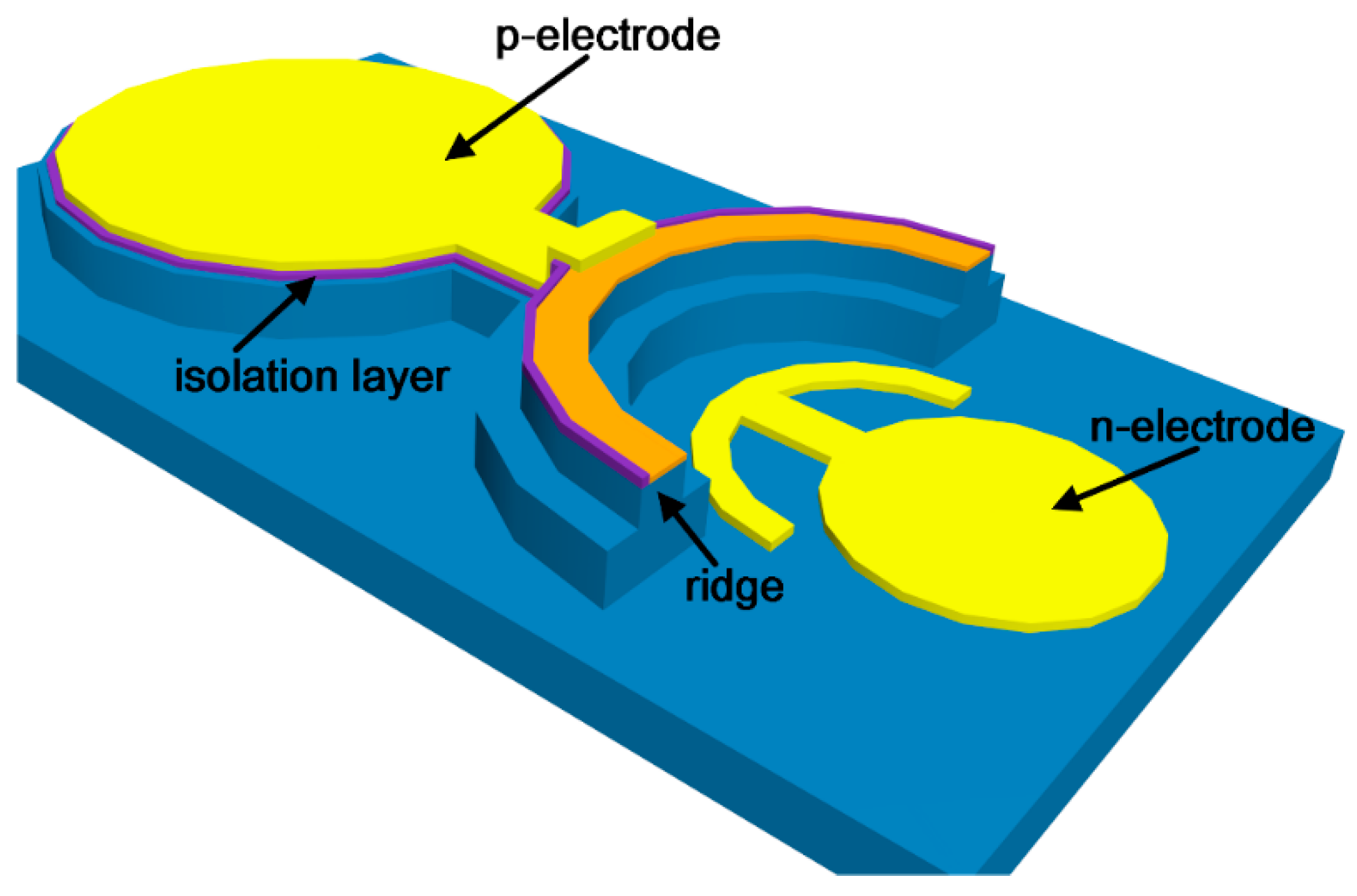
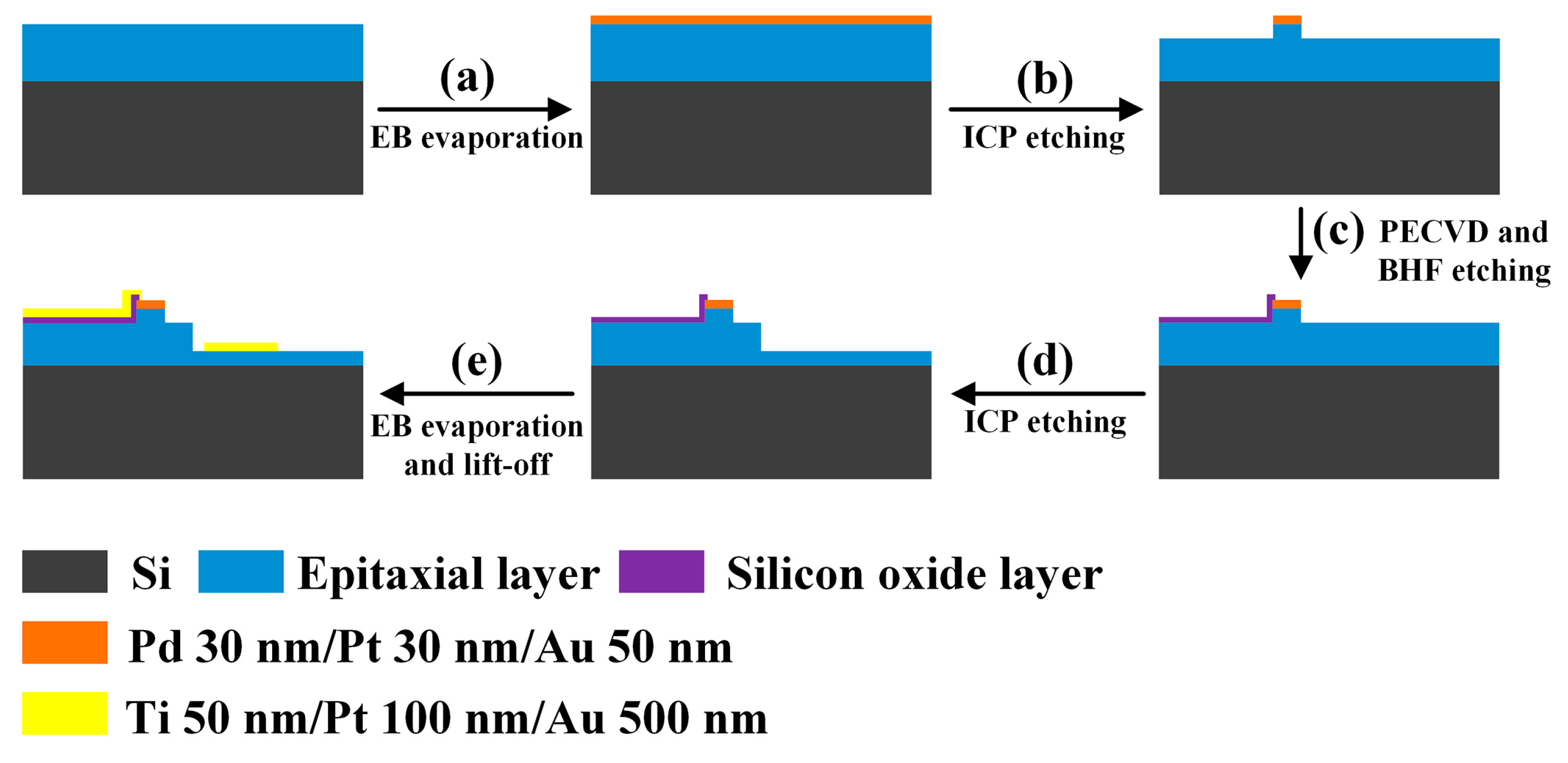
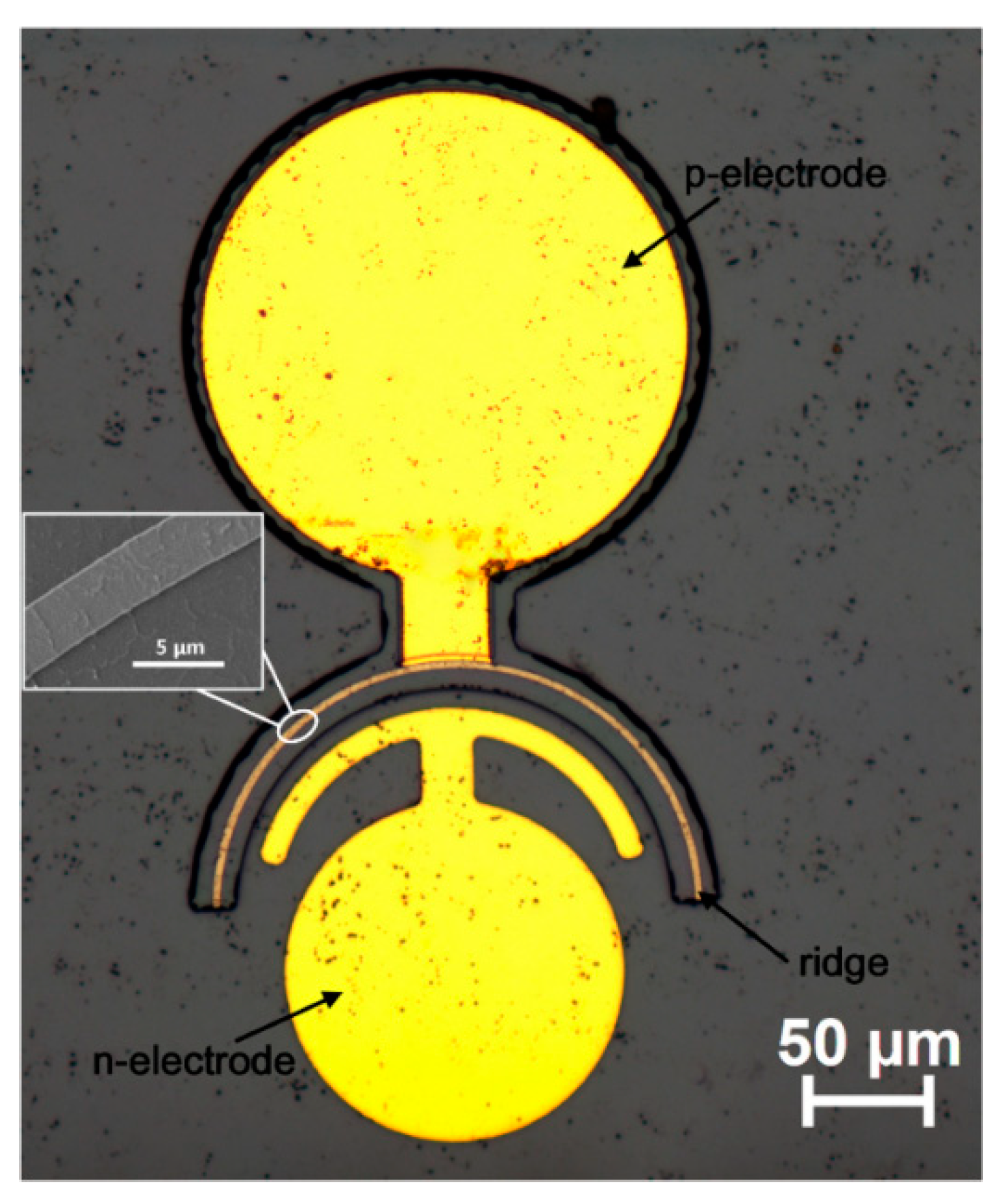
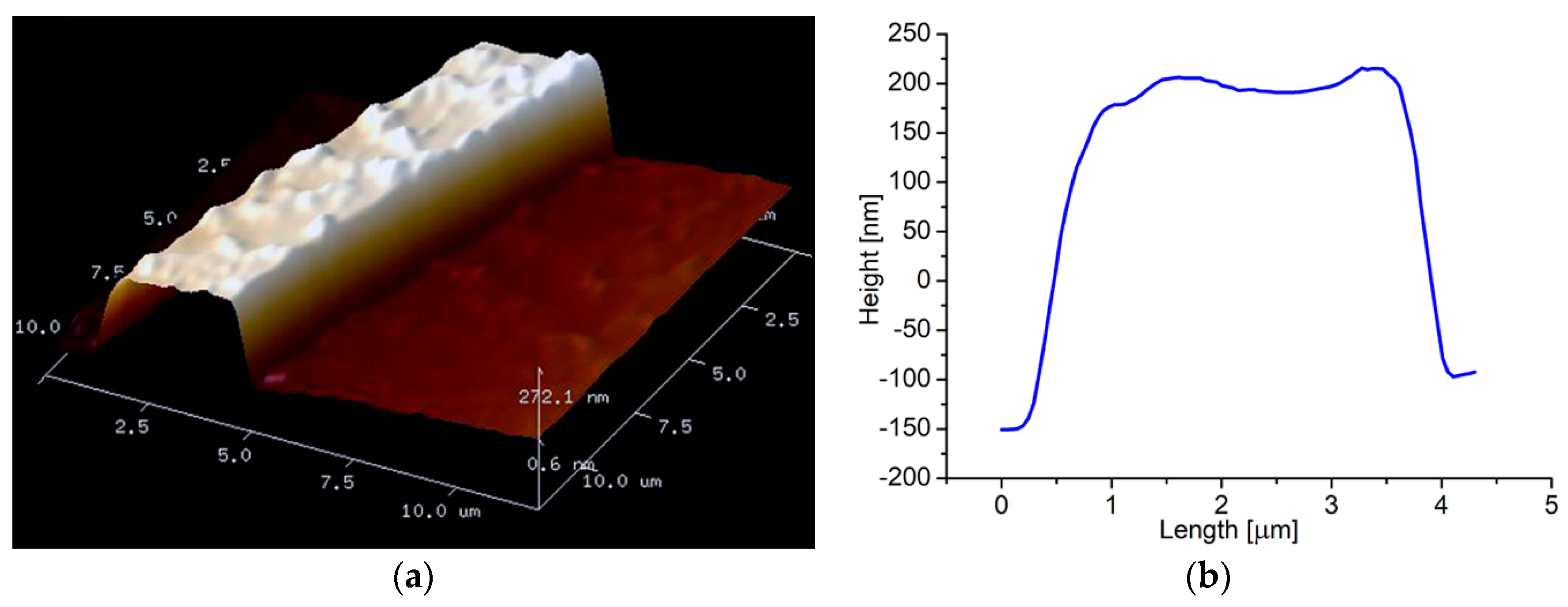
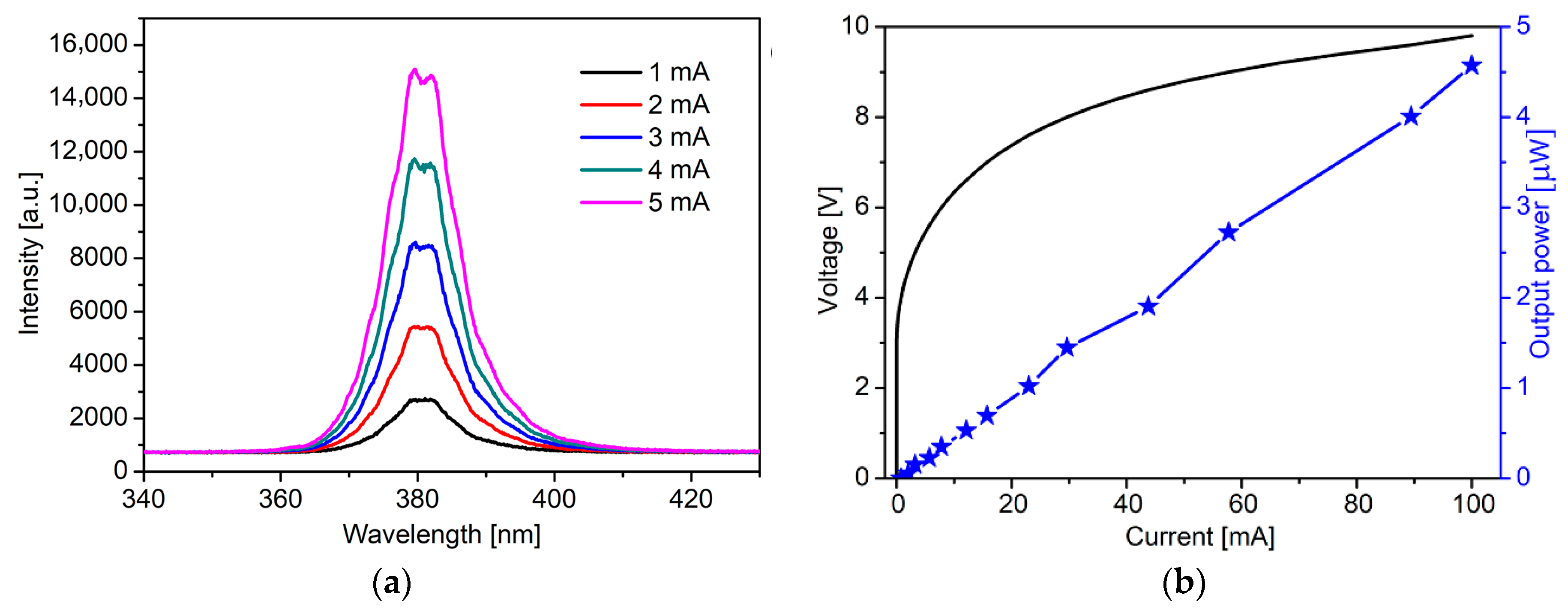
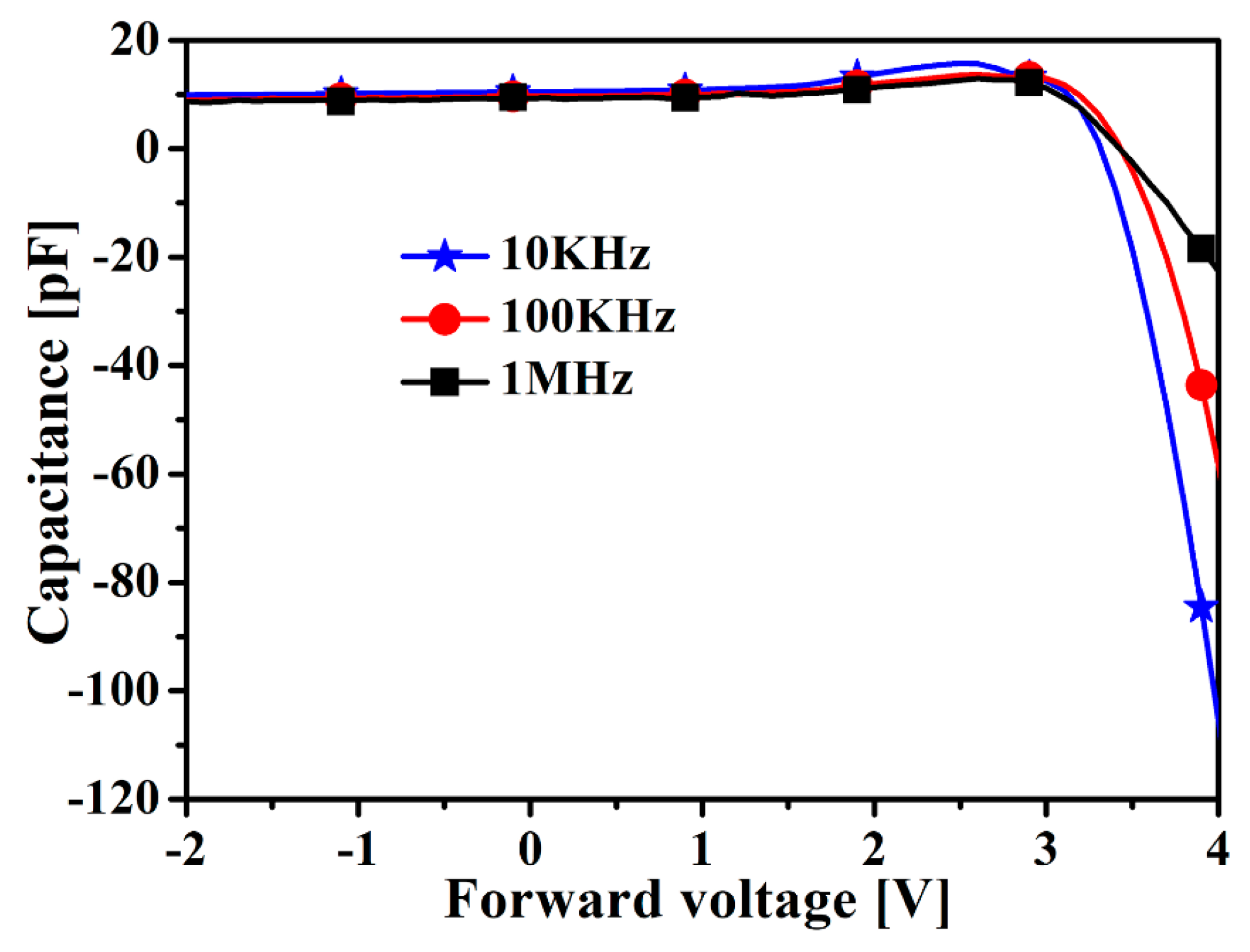
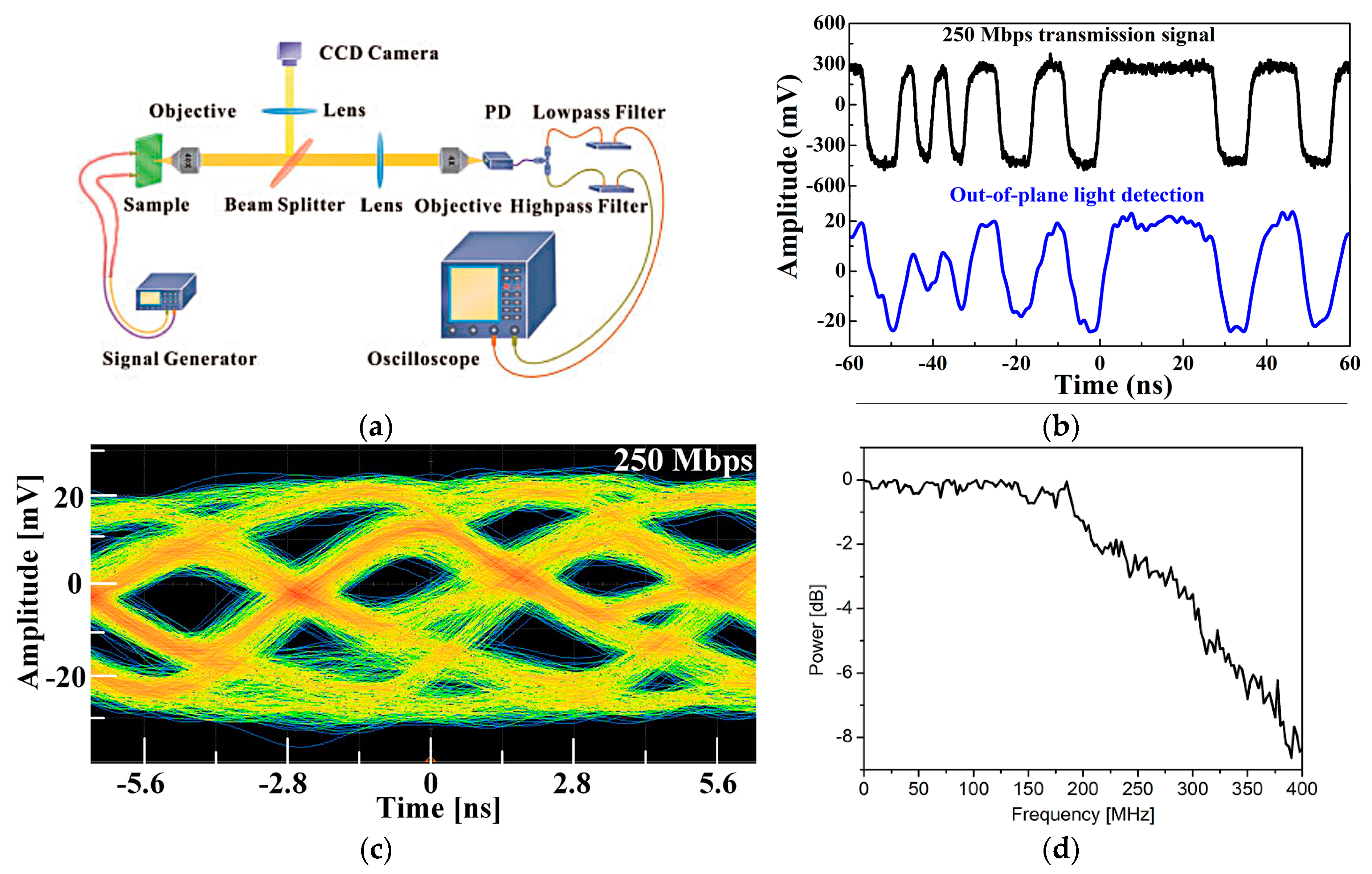
© 2020 by the authors. Licensee MDPI, Basel, Switzerland. This article is an open access article distributed under the terms and conditions of the Creative Commons Attribution (CC BY) license (http://creativecommons.org/licenses/by/4.0/).
Share and Cite
Li, X.; Wu, Y.; Yuan, J.; Ni, S.; Qin, C.; Jiang, Y.; Li, J.; Wang, Y. High-Speed Light Signal Transmitters for Optical Communication Based on Ultraviolet Radiation. Appl. Sci. 2020, 10, 693. https://doi.org/10.3390/app10020693
Li X, Wu Y, Yuan J, Ni S, Qin C, Jiang Y, Li J, Wang Y. High-Speed Light Signal Transmitters for Optical Communication Based on Ultraviolet Radiation. Applied Sciences. 2020; 10(2):693. https://doi.org/10.3390/app10020693
Chicago/Turabian StyleLi, Xin, Yue Wu, Jialei Yuan, Shuyu Ni, Chuan Qin, Yan Jiang, Jie Li, and Yongjin Wang. 2020. "High-Speed Light Signal Transmitters for Optical Communication Based on Ultraviolet Radiation" Applied Sciences 10, no. 2: 693. https://doi.org/10.3390/app10020693





